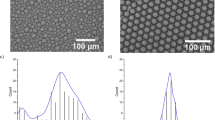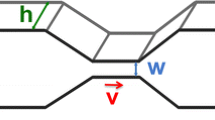Abstract
A microfluidic device for production of uniform size capsules with a prescribed membrane thickness is described. It is versatile, novel and suitable for various polymerization reactions. Parameters such as polymerization time and reagent concentrations can be precisely tuned to control the membrane properties. The device features a part which allows to overcome the diffusion barrier by initiating interfacial polymerization via chaotic mixing. It also allows the termination of the reaction and the collection of the resulting capsules. We observe different typical dynamical phenomena occurring in capsules during their flow along the microchannel, namely wrinkling of the membrane, parachute and bullet shapes and bursting of the capsules due to strong hydrodynamical flow. In addition to production, the monitoring of capsule dynamics in flow gave a possibility to estimate the elastic surface modulus \(E_{{\rm S}}\) and the membrane thickness t. We found that \(E_{{\rm S}}\) can be as low as 6 × 10−3 N m−1 and that the thickness can be below 100 nm. This microfluidic device is therefore capable of producing uniform size capsule solutions with suitable membrane properties for the controlled release of drugs, and as a model system of red blood cells for microhydrodynamics experiments.










Similar content being viewed by others
Notes
In small capillaries the mean velocity of blood reaches values up to 1 mm s−1 (Tortora and Derrickson 2012). The RBC size is close to the vessel size, and the capillary number can be as high as \(Ca=\frac{\eta U}{E_{{\rm s}}}\sim 0.2\), where U is the mean velocity of the blood flow. The membrane is deformed, and the RBCs adopt a parachute shape.
In the aorta, the diameter is approximately 2.25 cm and the mean velocity of the blood reaches 40 cm s−1 (Tortora and Derrickson 2012). Considering a Poiseuille flow for such vessel size and low velocity values, the shear rates can reach up to 150 s\(^{-1}\) near the vessel wall. For this shear rate and the plasma viscosity, we find the capillary number \(Ca=\frac{\eta \dot{\gamma } R}{E_{{\rm S}}}\sim 0.24\), so the membrane is easily sheared by the flow and must exhibits a SW motion.
This values are obtained for high pressures in the PDMS microstructure (\(\approx\)1 atm) It is possible to reduce again these times by increasing the pressure drop up to 2 atm which is a limit for PDMS microchannels. It is easy to increase the polymerzation time above one minute by decreasing the pressure on the two side microchannels that supplies the chaotic mixer with monomers.
We should take into account the fact that the presence of the drop compresses the two fluid layers, thus reducing their thickness. But as we consider a very wide channel the magnitude order of the result stays the same. This is not the case when the drop size is comparable with the channel size as in the work by Chu et al.
We find this value via the Stokes–Einstein equation for a viscosity of 250 mPa s and the hydrodynamic radius of sucrose which is a molecule with similar size as acyl chloride, \(R_{H} \approx\) 5 × 10−10 m.
Depending on the recepe, the diffusion coefficient of the amine monomer through the membrane can span a wide range of values from 10\(^{-15}\) up to 10\(^{-11}\) m\(^{2}\) s\(^{-1}\), see Perignon et al. (2015).
References
Abkarian M, Faivre M, Viallat A (2007) Swinging of red blood cells under shear flow. Phys Rev Lett 98(18):188302. doi:10.1021/ja00089a029
Anna SL, Bontoux N, Stone HA (2003) Formation of dispersions using “flow focusing” in microchannels. Appl Phys Lett 82(3):364–366. doi:10.1063/1.1537519
Cerda E, Mahadevan L (2003) Geometry and physics of wrinkling. Phys Rev Lett 90(7):074302. doi:10.1103/PhysRevLett.90.074302
Chabanel A, Schachter D, Chien S (1987) Increased rigidity of red blood cell membrane in young spontaneously hypertensive rats. Hypertension 10:603–607. doi:10.1161/01.HYP.10.6.603
Chang KS, Olbricht WL (1993) Experimental studies of the deformation and breakup of a synthetic capsule in steady and unsteady simple shear flow. J Fluid Mech 250:609–633. doi:10.1017/S0022112093001582
Chu TX, Salsac AV, Barthès-Biesel D, Griscom L, Edwards-Lévy F, Leclerc E (2013) Fabrication and in situ characterization of microcapsules in a microfluidic system. Microfluid Nanofluid 14(1–2):309–3117. doi:10.1007/s10404-012-1049-9
Datta SS, Abbaspourrad A, Amstad E, Fan J, Kim SH, Romanowsky M, Shum HC, Sun B, Utada AS, Windbergs M, Zhou S, Weitz DA (2014) 25th anniversary article: double emulsion templated solid microcapsules: mechanics and controlled release. Adv Mater 26:2205–2218. doi:10.1021/ja00089a029
Deschamps J, Kantsler V, Segre E, Steinberg V (2009a) Dynamics of a vesicle in general flow. PNAS 106(28):11444–11447. doi:10.1073/pnas.0902657106
Deschamps J, Kantsler V, Steinberg V (2009b) Phase diagram of single vesicle dynamical states in shear flow. Phys Rev Lett 102(11):118105. doi:10.1103/PhysRevLett.102.118105
Dupont C, Salsac AV, Barthès-Biesel D, Vidrascu M, Le Tallec P (2015) Influence of bending resistance on the dynamics of a capsule in shear flow. Phys Fluids 27:051902. doi:10.1063/1.4921247
Finken R, Seifert U (2006) Wrinkling of microcapsules in shear flow. J Phys Condens Matter 18:L185–L191. doi:10.1088/0953-8984/18/15/L04
Fisher M (2004) Shape memory of human red blood cells. Biophys J 86(5):3304–3313. doi:10.1021/ja00089a029
Garstecki P, Stone HA, Whitesides GM (2005) Mechanism for flow-rate controlled breakup in confined geometries: a route to monodisperse emulsions. Phys Rev Lett 94(16):164501. doi:10.1103/PhysRevLett.94.164501
Hennequin Y, Pannacci N, Torres CP, Tetradis-Meris G, Chapuliot S, Bouchaud E, Tabeling P (2009) Synthesizing microcapsules with controlled geometrical and mechanical properties with microfluidic double emulsion technology. Langmuir 25(14):7857–7861. doi:10.1021/la9004449
Holmes DP, Crosby AJ (2010) Draping films: a wrinkle to fold transition. Phys Rev Lett 105(3):038303. doi:10.1103/PhysRevLett.105.038303
Janssen LJJM, Nijenhuis KT (1992) Encapsulation by interfacial polycondensation. II. The membrane wall structure and the rate of the wall growth. J Membr Sci 65:59–68. doi:10.1016/0376-7388(92)87054-2
Kessler S, Finken R, Seifert U (2008) Swinging and tumbling of elastic capsules in shear flow. J Fluid Mech 605:207–226. doi:10.1021/ja00089a029
Kuriakose S, Dimitrakopoulos P (2011) Motion of an elastic capsule in a square microfluidic channel. Phys Rev E 84(1):011906. doi:10.1021/ja00089a029
Lac E, Barthès-Biesel D, Pelekasis NA, Tsamopoulos J (2004) Spherical capsules in three-dimensional unbounded Stokes flows: effect of the membrane constitutive law and onset of buckling. J Fluid Mech 516:303–334. doi:10.1017/S002211200400062X
Lee JS, Fung YC (1969) Modeling experiments of a single red blood cell moving in a capillary blood vessel. Microvasc Res 1(3):221–243. doi:10.1016/0026-2862(69)90025-9
Mayya KS, Bhattacharyya A, Argillier JF (2003) Micro-encapsulation by complex coacervation: influence of surfactant. Polym Int 52(4):644–647. doi:10.1002/pi.1125
Meyer R (2005) Delivery system handbook for personal care and cosmetic products—technology, applications. William Andrew Inc, NewYork
Perignon C, Ongmayeb G, Neufeld R, Frere Y, Poncelet D (2015) Microencapsulation by interfacial polymerization: membrane formation and structure. J Microencapsul Micro Nano Carr 32(1):1–15. doi:10.3109/02652048.2014.950711
Polenz I, Weitz DA, Baret JC (2014) Polyurea microcapsules in microfluidic: surfactant control of soft membranes. Langmuir 31(3):1127–1134. doi:10.1021/la5040189
Polenz I, Brosseau Q, Baret JC (2015) Monitoring reactive microencapsulation dynamics using microfluidics. Soft Matter 11(15):2916–2923. doi:10.1016/j.piutam.2015.03.014
Renckens TJA, Janeliunas D, Vliet HV, Esch JHV, Mulac G, Kreutzer MT (2011) Micromolding of solvent resistant microfluidic devices. Lab Chip. doi:10.1039/C0LC00550A
Risso F, Collé-Paillot F, Zagoule M (2006) Experimental investigation of a bioartificial capsule flowing in a narrow tube. J. Fluid Mech 547:149173. doi:10.1017/S0022112005007652
Skalak R, Branemark PI (1969) Deformation of reb blood cells in capillaries. Science 164(3880):717–719. doi:10.1126/science.164.3880.717
Soto-Portas ML, Argillier JF, Méchin F, Zydowicz N (2003) Preparation of oily core polyamide microcapsules via interfacial polycondensation. Polym Int 52(4):522–527. doi:10.1002/pi.1022
Stone HA (2007). In: Lee H. Ham D, Westervelt RM (eds) CMOS Biotechnology. Springer, NewYork
Stroock AD, Dertinger SKW, Ajdari A, Mezić I, Stone HA, Whitesides GM (2002) Chaotic mixer for microchannels. Science 295(5555):647–651. doi:10.1126/science.1066238
Tana YC, Cristinia V, Leea AP (2006) Monodispersed microfluidic droplet generation by shear focusing microfluidic device. Sens Actuat B 114(1):350–356. doi:10.1016/j.snb.2005.06.008
Tortora GJ, Derrickson BH (2012) Principles of anatomy and physiology, 13th edn. Wiley, Hoboken
Vandeparre H, Piñeirua M, Brau F, Roman B, Bico J, Gay C, Bao W, Lau CN, Reis PM, Damman P (2011) Wrinkling hierarchy in constrained thin sheets from suspended graphene to curtains. Phys Rev Lett 106(22):224301. doi:10.1103/PhysRevLett.106.221101
Walter A, Rehage H, Leonhard H (2001) Shear induced deformation of microcapsules: shape oscillations and membrane folding. Coll Surf A Physicochem Eng Asp 183:123–132. doi:10.1016/S0927-7757(01)00564-7
Waugh R, Evans EA (1979) Thermoelasticity of red blood cell membrane. Biophys J 26(1):115–131. doi:10.1016/S0006-3495(79)85239-X
Acknowledgements
This work is partially supported by Grant from the German–Israel Foundation.
Author information
Authors and Affiliations
Corresponding author
Rights and permissions
About this article
Cite this article
Gallé, N., Steinberg, V. On-chip encapsulation via chaotic mixing. Microfluid Nanofluid 20, 156 (2016). https://doi.org/10.1007/s10404-016-1820-4
Received:
Accepted:
Published:
DOI: https://doi.org/10.1007/s10404-016-1820-4




